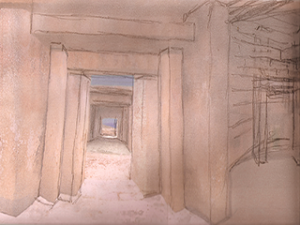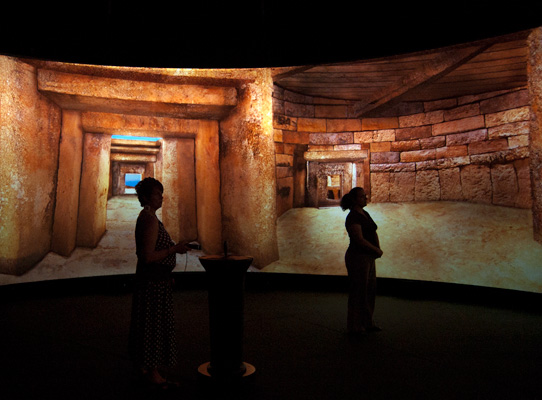The digital production of Spaces of Mnajdra involved a lengthy design and production process including recording of the archaeological materials; development of the ‘Neolithic world’; visualisation and sound design and interaction design for visitor movement.
Digital Construction
The visualisation of the temples of Mnajdra was constructed from detailed photography of the landscape, site, internal structure and architectural features. With the generous permission of Heritage Malta, filming was undertaken in all the side chambers and hidden intramural room (between the walls) using a dedicated panoramic rig to provide a complete picture of the environment. Graffiti, signage and installed barriers were digitally removed to support archaeological interpretation and images colour matched.
 Based on historical research and architectural analysis another matching set of panoramas was developed through a process of digital reconstruction. Working with a team of matte painters – the present day structural remains were reworked to replace missing uprights and lintels and to extend walls to form enclosed chambers and complete arched roofing structures. Through careful analysis of architectural modelling a number of the chambers were completely covered with some remaining semi-enclosed. The direction and intensity of the lighting then needed to reflect these changed environmental conditions. Through digital manipulation the panoramas were further modified to imply directional natural light through doorways with some low level internal ambient lighting.
Based on historical research and architectural analysis another matching set of panoramas was developed through a process of digital reconstruction. Working with a team of matte painters – the present day structural remains were reworked to replace missing uprights and lintels and to extend walls to form enclosed chambers and complete arched roofing structures. Through careful analysis of architectural modelling a number of the chambers were completely covered with some remaining semi-enclosed. The direction and intensity of the lighting then needed to reflect these changed environmental conditions. Through digital manipulation the panoramas were further modified to imply directional natural light through doorways with some low level internal ambient lighting.
The Advanced Visualisation and Interaction Environment
 The Advanced Visualisation and Interaction Environment (AVIE) is a purpose built system for stereoscopic visualisation and motion tracking. In Spaces of Mnajdra the circular display screen and tracking technology is designed for 3 visitors at any one time to have an interactive experience of the temple environment. The interaction matrix can also be adapted to provide an audience viewing area within the installation for up to 15 viewers.
The Advanced Visualisation and Interaction Environment (AVIE) is a purpose built system for stereoscopic visualisation and motion tracking. In Spaces of Mnajdra the circular display screen and tracking technology is designed for 3 visitors at any one time to have an interactive experience of the temple environment. The interaction matrix can also be adapted to provide an audience viewing area within the installation for up to 15 viewers.
A pedestal-mounted sensor ‘wand’ located in the centre of the room is an inert cube device that can detect which way it is pointing in 3D space. Through pointing or rolling the wand, visitors can view architectural details and textures in the panoramic display, enlarge and rotate artefacts and activate the playback of location specific environmental soundscapes.
Motion Tracking
![]() The motion tracking system detects the position of participants through an infrared camera system mounted on the ceiling and sides of the circular room. ‘Point based tracking’ is used to calibrate visitors movement and to mirror that movement in the form of on-screen ‘virtual shadows’. This feedback process takes place in real time generating real time body outlines depending on where the visitor is located without the use of cables or attached sensors. Visitors can thus experience full and unencumbered exploratory range within the 10-meter diameter space of the circular room and can see their own virtual shadow outline moving through the forecourt and the internal chambers of the temple environment.
The motion tracking system detects the position of participants through an infrared camera system mounted on the ceiling and sides of the circular room. ‘Point based tracking’ is used to calibrate visitors movement and to mirror that movement in the form of on-screen ‘virtual shadows’. This feedback process takes place in real time generating real time body outlines depending on where the visitor is located without the use of cables or attached sensors. Visitors can thus experience full and unencumbered exploratory range within the 10-meter diameter space of the circular room and can see their own virtual shadow outline moving through the forecourt and the internal chambers of the temple environment.